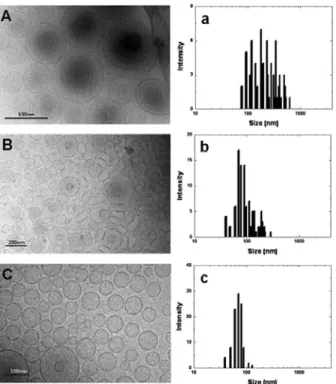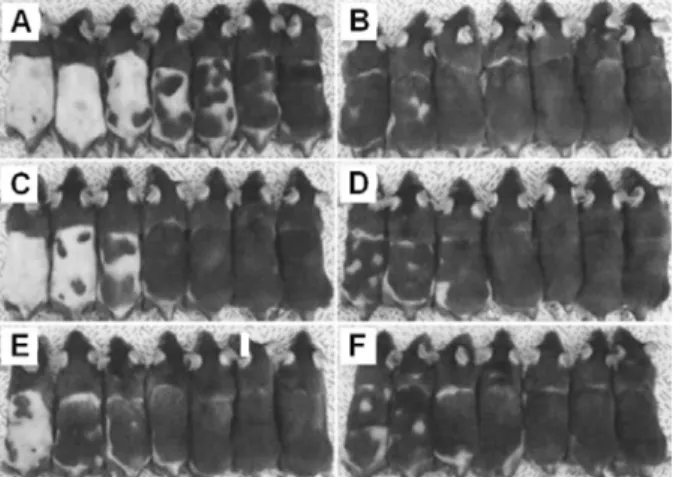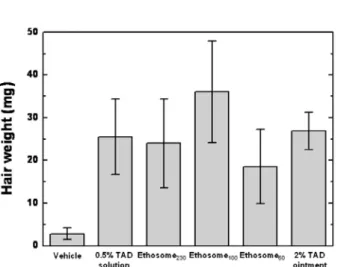에토좀 입자크기와 멤브레인 특성 조절을 통한 약물의 경피흡수능 향상
안 은 정*,†⋅심 종 원*⋅최 장 원*,**⋅김 진 웅*⋅박 원 석*⋅김 한 곤*⋅박 기 동**⋅한 성 식***
*아모레 퍼시픽 기술연구원, **아주대학교 분자과학기술학과, ***고려대학교 생명과학대학 (2010년 6월 15일 접수, 2010년 6월 20일 수정, 2010년 6월 22일 채택)
Enhanced Transdermal Delivery of Drug Compounds Using Scalable and Deformable Ethosomes
Eun Jung An*,†, Jongwon Shim*, Jang Won Choi*,**, Jin-Woong Kim*, Won Seok Park*, Han-Kon Kim*, Ki-Dong Park**, and Sung-Sik Han***
*Amore-Pacific Co. R&D Center, 314-1, Bora-Dong, Giheung-Gu, Yongin, Gyeonggi-Do 446-729, Korea
**Department of Molecular Science and Technology, Ajou University
***Division of Life Science, College of Life Science and Biotechnology, Korea University (Received June 15, 2010; Revised June 20, 2010; Accepted June 22, 2010)
요 약: 본 연구에서는 입자 크기 뿐만 아니라 베지클 멤브레인의 변형도를 조절할 수 있는 에토좀을 통해 약물의 경피흡
수능을 향상시킬 수 있는 새로운 접근을 소개한다. 이를 위해 신규 육모효능성분인 Triaminodil을 포집한 에토좀을 제조 하였고 입자 제조 후 추가적인 에너지를 가함으로써 입자의 크기를 조절하였다. 광산란법, 투과전자현미경, 멤브레인
변형도 측정 등을 통해 입자의 변형도가 입자 크기에 의존하는 것을 확인하였다. 또한
in vitro피부흡수시험과 전임상
성장기 유도평가를 통해 베지클 멤브레인의 변형도가 Triaminodil의 피부 전달효능에 크게 영향을 미치는 것을 확인하 였다. 이러한 결과로부터 담지 된 약물의 전달효능을 극대화 시킬 수 있는 최적 크기의 전달체 영역이 존재함을 확인하 였고 이는 입자의 크기와 멤브레인 특성에 큰 영향을 받기 때문에 전달체를 설계하는데 있어 이 두 가지 요인을 고려해 야 한다.
Abstract: This study introduces a flexible approach to enhance skin permeation by using ethosomes with deformable lipid membranes as well as controllable sizes. To demonstrate this, a set of ethosomes encapsulating an anti-hair loss ingredient, Triaminodil
TM, as a model drug, were fabricated with varying their size, which was achieved by solely applying the different level of mechanical energy, while maintaining their chemical composition. After character- ization of the ethosomes with dynamic light scattering, transmission electron microscopy, and deformability measure- ments, it was found that their membrane deformability depended on the particle size. Moreover, studies on
in vitroskin permeation and murine anagen induction allowed us to figure out that the membrane deformability of ethosomes essentially affects delivery efficiency of Triaminodil
TMthrough the skin. It was noticeable in our study that there ex- isted an optimum particle size that can not only maximize the delivery of the drug through the skin, but also increase its actual dermatological activity. These findings offer a useful basis for understanding how ethosomes should be de- signed to improve delivery efficiency of encapsulated drugs therein in the aspects of changing their length scales and membrane properties.
Keywords:
ethosomes, particle size, deformability, skin permeation, anti-hair loss ingredient
1)
† 주 저자 (e-mail: ejan@amorepacific.com)



